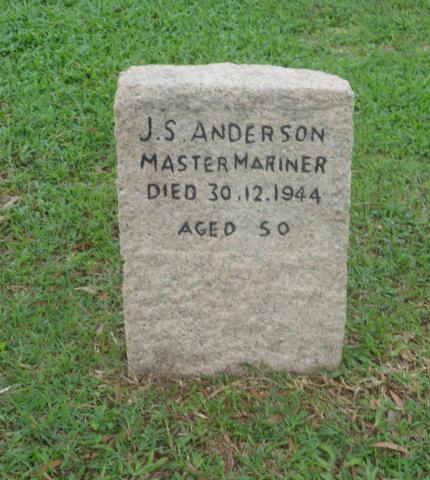A day of prolonged aerial bombardment, ending in tragedy.
The bombing begins at 8.30 a.m. and goes on for about 4 hours. Then it moves closer to Stanley. Mutal Fielder is walking back from a lecture with her Russian teacher 39 year old Government cadet, Stephen Balfour; they are continuing the discussion of Pushkin:
The path forked and Stephen turned to the right, walking towards Bungalow C, where he lived with a group of other internees, and I went to the left towards the Indian quarters. Suddenly there was the roar of aircraft and the sound of explosions as bombs were dropped.
Two American aircraft collide and one pilot parachutes out in full view of the internees. Three bombs drop on Stanley Prison from where a gun's been firing.
George Wright-Nooth:
A fourth bomb landed outside the prison walls. While all this was going on we had a magnificent view of the planes as they dived over. They carried one long bomb underneath.
A bomb hits Bungalow C between the main building and the garage and 14 people are killed. One man, Mr. C. T. Bailey, is talking to one of the victims but survives because he's protected by a pillar.
Edith Hamson:
Agonising screams penetrated the deep rumble of the continuing battle...Men from our bungalow {A} rushed outside in an attempt to save the injured, but they were forced back by gunfire.
Margaret Louisa ('Peggy') Davies, a 35 year old school teacher, lies dead, buried in the rubble with her left arm sticking out and gold wedding ring visible. It's looted, like much else from the Bungalow.
A Japanese guard arrives and makes all present stand in silence while he presents arms.
The other victims were:
Sidney Frank Bishop, aged 51 (Green Island Cement Company)
Oscar Eager, 57 (Hong Kong Land Investment)
Mrs A. T. Shields Guerin, 57 (homemaker)
Adam Morrison Holland, 53 (Public Works Department, Inspector)
Alexander H. Hyde Lay, 51, (merchant)
Elizabeth Fleming ('Betty') Hyde Lay, 51 (home maker)
Mabel Searle, 40 (home maker)
Edward Valentine Searle, 53 (electrical engineer)
George Gordon Stopani-Thompson, 41 (electrical engineer)
George Willoughby, 46 (Watson's chemist)
Isabelle Johnson, 54
Albert James Dennis, 56 (Dodwell & Co.)
Sources:
Balfour: Derek Round, Barbed Wire Between Us, 2002, 152
Fighting, Davies: George Wright-Nooth, Prisoner of the Turnip Heads, 1994, 239-240
Hamson: Allana Corbin, Prisoners of the East, 2002, 254
Names of Victims: Geoffrey Emerson, Hong Kong Internment, 1942-1945, Appendix 111.
Note:
Accounts of this day differ in details; I've tried to put together a plausible composite.
In an article in the 2017 edition of the Journal of the Royal Asiatic Society, Hong Kong Branch, Steven K. Bailey argues that the bombing was not, as usually claimed, accidental, but a deliberate attempt to destroy what were believed to be Japanese installations. The pilots, he suggests, did not know the internment camp was where it was, and their mission reports indicate that they never realised they had dropped bombs on Allied civilians. Bailey makes a powerful case, but there is as yet no positive statement of pilot ignorance to clinch his hypothesis.
